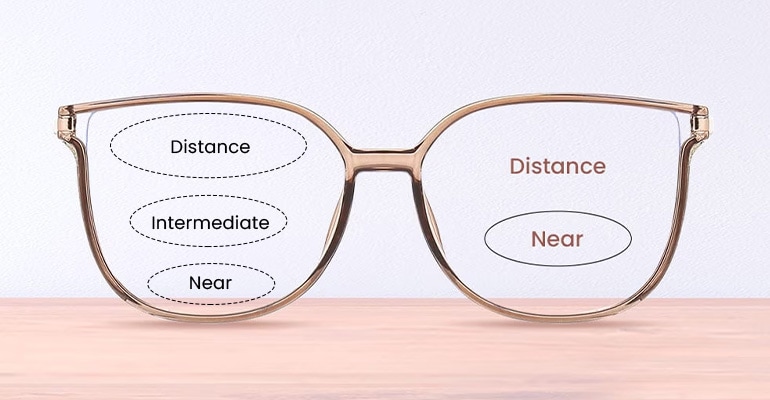Bifocals vs Progressive Lenses: Choosing the Right Vision Solution
Mar 28, 2024

Choosing the right type of corrective lenses is crucial for individuals with vision problems requiring multiple focal points. Bifocals and progressive lenses both aim to address this need, but they do so in distinctly different ways. Bifocals are the more traditional option, having two distinct areas of vision correction, typically for distance and near vision, separated by a visible line on the lens. They have been a reliable choice for people who need glasses for both reading and activities that require distance vision.
In contrast, progressive lenses offer a more modern solution by providing a gradient of multiple corrective powers with no visible lines on the lens. This design allows for a smooth transition from distance correction at the top to intermediate and then near correction at the bottom. As a result, progressive lenses can offer a more natural visual experience, similar to that of natural eyesight, by accommodating different visual needs in one seamless lens.
The relatively line-free appearance of progressive lenses also appeals to many because it avoids the distinct demarcation present on bifocals, which can sometimes be seen as an indicator of aging. However, the choice between bifocals and progressive lenses often depends on personal preferences, specific vision requirements, and how quickly an individual can adapt to the different styles of vision correction that these lenses offer.
Understanding Vision Problems
Vision issues often result from the eye's declining ability to focus due to aging or specific refractive errors. Proper correction is crucial for clear vision, with options such as bifocals and progressive lenses catering to different needs.
Presbyopia and Age-Related Changes
Presbyopia is an age-related condition where the eyes progressively lose the ability to focus on nearby objects. This condition generally becomes noticeable in individuals around the age of 40. The primary cause of presbyopia is the hardening of the eye's lens, which inhibits its ability to change shape and focus on closer objects.
Nearsightedness vs. Farsightedness
-
Nearsightedness (myopia): Individuals see close objects clearly, but distant objects appear blurred.
-
Farsightedness (hyperopia): Individuals struggle to see nearby objects, while far objects remain clear.
Both conditions stem from the shape of the eye affecting the direction in which light focuses relative to the retina.
Table 1: Differences between Myopia and Hyperopia
| Condition | Also Known As | Vision Impact | Cause |
| Myopia | Nearsighted | Distant blur | Light focuses before it reaches the retina |
| Hyperopia | Farsighted | Close-range blur | Light focuses behind the retina |
Astigmatism and Complex Prescriptions
Astigmatism is caused by an irregularly shaped cornea or lens, leading to blurred or distorted vision at all distances. It often accompanies nearsightedness or farsightedness, resulting in complex prescriptions that require lenses with multiple focal points to correct various vision problems simultaneously.
The image above is Bifocal lenses details
Types of Corrective Lenses
Corrective lenses come in various types, each designed to address specific vision needs. This section will explore the differences between bifocal and progressive lenses, delve into the realm of trifocals and single vision lenses, and examine the benefits of specialty lenses and their coatings.
Comparing Bifocals and Progressives
Bifocal lenses feature two distinct optical powers – one for distance vision and another for close-up tasks. This kind of lenses are also called lenses with flat top and this design makes the transition between the near and distance parts of the lens less noticeable than other bifocal styles. They are easily identified by a visible line dividing the two sections. In contrast, progressive lenses offer a gradient of varying optical strengths, providing a smooth transition from distance to near vision without any visible lines.

The image above is Bifocal lenses details
-
-
Distance and near correction
-
Visible line on lens
-
-
Progressive Lenses:
-
Distance, intermediate, and near correction
-
No visible line for a seamless look
-

The image above is Progressive lenses details
Trifocals and Single Vision Lenses
Trifocals, like bifocals, have distinct sections for different viewing distances, but they include an additional intermediate zone. This makes them suitable for someone who needs clear vision at three distinct distances. On the other hand, single vision lenses have only one corrective power throughout the entire lens, which is ideal for individuals who require correction for either distance, intermediate, or near vision exclusively.
-
Trifocals:
-
Distance, intermediate, and near correction
-
Visible lines on lens
-
-
-
One corrective power
-
No lines on lens
-
Specialty Lenses and Coatings
The eye care technology has expanded to include specialty lenses and coatings that enhance the durability and functionality of corrective lenses. A scratch-resistant coating helps protect lenses from everyday wear and tear, while UV protection filters out harmful ultraviolet rays, contributing to overall eye health.
-
-
Scratch-resistant: Reduces surface damage to lenses
-
UV protection: Shields eyes from harmful ultraviolet radiation
-
Benefits and Limitations
Selecting the right eyewear is crucial for optimal vision correction and comfort. In comparing bifocals and progressive lenses, consumers must consider multifocal vision correction, how they impact lifestyle, and their aesthetic preferences.
Vision Correction and Comfort
Bifocal Lenses:
-
Vision Correction: They provide clear vision at two distances: near and far.
-
Comfort: Bifocals are easier to adjust to with a distinct separation between reading and distance zones.
Progressive Lenses:
-
Vision Correction: Offer seamless transition between multiple viewing zones, including intermediate distances.
-
Comfort: May take longer to adapt to, but provide a balanced and comfortable view once acclimatized.
Adapting to Life with Multifocals
Bifocal Lenses:
-
Users need to adjust to looking through the correct part of the lens for clear vision which may be disorienting initially.
Progressive Lenses:
-
Adapting involves learning to look through progressively changing lens powers, which can require a period of adaptation for the eyes and brain.
Aesthetics and Lifestyle Impact
Bifocal Lenses:
-
Aesthetics: Visible lines may be less appealing to some users.
-
Lifestyle: Ideal for those who prioritize a larger reading area over a line-free appearance.
Progressive Lenses:
-
Aesthetics: No visible lines for a more youthful, line-free appearance.
-
Lifestyle: Suited for an active lifestyle with a need for natural vision at all distances.
Choosing the Right Glasses
When selecting eyeglasses, consumers must evaluate their daily routines, the compatibility of frames with lens types, and the investment required for high-quality eyewear.
Considering Your Daily Activities
Opting for bifocals can suit those with a more routine set of activities, involving distinct near and far focus, like reading and driving.
Progressive lenses, on the other hand, are ideal for a dynamic lifestyle that requires seamless transition across multiple focal points, catering to activities like using digital devices, reading, and interacting at different distances.
Matching Frames with Lens Types
It is crucial to pair the correct frames with the chosen lens type. Progressive lenses demand frames with sufficient vertical height to accommodate the gradient of focal powers. Whereas bifocals are more flexible, allowing for a wider array of frame choices, since the bifocal segment is typically confined to a lower portion of the lens.
Suitable Frame Styles:
-
Progressive lenses: Larger frames with ample lens height
-
Bifocals: Most frame styles, with preference for those that provide enough lens depth for the bifocal window
Budgeting for Eyewear
Eyewear cost can vary considerably, with progressive lenses typically being more expensive due to their more complex design compared to bifocals. When budgeting, shoppers should remember that while affordable options are available, choosing a higher quality lens can be a worthwhile investment for better vision and comfort. It's also advisable to consider long-term needs, as investing in a durable pair of glasses could prove more cost-effective over time.
Cost Comparison:
-
Standard Progressive Lenses: Starting at $37.95
-
Premium Progressive Lenses: Starting at $52.95
-
Bifocals: Typically less expensive than progressives
Professional Advice and Examinations
Selecting the right type of corrective lenses is a decision that should be made with professional guidance. It involves a detailed examination of your vision and understanding your lifestyle needs.
The Role of Optometrists and Opticians
Optometrists are eye care professionals who specialize in vision testing and are qualified to diagnose and manage vision problems. They perform comprehensive eye exams which are critical in determining the correct eyeglass prescription.
Opticians, on the other hand, are technicians trained to design, verify, and fit eyeglass lenses and frames. Together, these professionals ensure that patients receive optimal corrective lenses, whether bifocals or progressives, based on their prescriptions.
Understanding Your Prescription
A precise eyeglass prescription is crucial for clear vision. Prescriptions detail the lens power needed to correct refractive errors such as nearsightedness, farsightedness, and astigmatism. They also indicate if bifocal or progressive lenses are needed.
Here's a simplified example of what an eyeglass prescription may look like:
| Sphere | Cylinder | Axis | Add |
| -1.25 | +0.50 | 180 | +2.00 |
| Right) | Right) | Right) | (Bifocal/Progressive Power) |
Sphere indicates the lens strength, Cylinder and Axis values are for astigmatism, and Add refers to the additional magnifying power for reading in bifocals or progressives.
Regular Eye Exams and Health
Regular eye exams are not only necessary for updating prescriptions but also for monitoring the overall health of one's eyes. Eye doctors can detect early signs of conditions like glaucoma, cataracts, and retinal issues during these exams. Adults should have their eyes examined at least once every two years, or more frequently if recommended by their eye care professional.
Advanced Progressive Lens Features
In the realm of multifocal vision correction, advanced progressive lenses stand out due to their sophisticated engineering and customization options, aimed at providing seamless visual transition across different distances.
Premium Progressive Lenses
Premium progressive lenses offer users an enhanced field of vision with less distortion than standard progressives. They typically provide up to a 40% wider field of view, which allows for a more comfortable visual experience and quicker adaptation. These lenses are constructed with advanced technology to minimize the "swim" effect—an issue where the periphery of the lenses can cause a swimming sensation to users.
Lens Designs for Specific Needs
The design of progressive lenses can be specialized to cater to individual visual requirements. For instance:
-
Occupational lenses: Designed specifically for certain professions, optimizing clarity for job-specific distances.
-
Outdoor lenses: Tailored for outdoor activities, featuring tints and coatings suitable for varying light conditions.
Manufacturers achieve this by altering the distribution of prescription power throughout the lens, catering to unique viewing habits and ensuring maximum visual efficiency.
Computer Glasses for Screen Work
For those who spend significant time in front of digital screens, computer glasses with progressive lenses are a game-changer. They are optimized to ensure clear vision at intermediate and near distances typical of computer and desk work. Unlike general progressives, these lenses reduce the need to tilt one's head to find the correct focal zone, which can lead to better posture and reduced neck strain.
Additional Considerations
When considering whether to choose bifocals or progressive lenses, one must not overlook factors like specialized eyewear options and alternatives such as contacts, as well as understanding the historical development of these vision aids.
Reading Glasses and Sunglasses Options
Individuals who opt for bifocals or progressives need to consider the compatibility of these lenses with reading glasses and sunglasses. Those who regularly engage with close-up activities may find that dedicated reading glasses offer a more specialized solution. Moreover, for outdoor activities, combining polarized sunglasses with bifocals or progressive lenses can significantly reduce glare, contributing to more comfortable and clearer vision in bright conditions.
Contact Lenses as an Alternative
For those seeking an option without frames, contact lenses offer a versatile alternative to traditional spectacles. They come in various forms, including multifocal and bifocal contacts, providing a solution for people who require correction for multiple distances but prefer not to wear glasses. Contacts can be particularly advantageous in active settings where glasses may be impractical.
The History and Evolution of Bifocals
Benjamin Franklin is often credited with the invention of the first bifocal lens, introducing a significant advancement in corrective eyewear. Bifocals were designed with distinct zones to assist with both near and distance vision. Over time, these have evolved into progressive lenses, which offer gradual changes in power without distinct lines. This evolution reflects continuous innovation in the field to enhance visual comfort and utility.